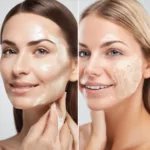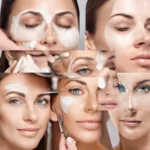29 December 2023
The Truth Unveiled: Debunking the Myth of Dermaplaning Making Wrinkles Worse
Does Dermaplaning Make Wrinkles Worse?
Smooth, youthful skin has always been a coveted attribute, and people are constantly seeking new treatments and techniques to achieve it. One popular method that has gained traction in recent years is dermaplaning, a non-invasive exfoliation procedure that promises to remove dead skin cells and peach fuzz, leaving behind a radiant complexion. However, as with any beauty trend, concerns and questions arise. One particular question that has been circulating is whether dermaplaning can actually make wrinkles worse. In this article, we will delve into the science behind dermaplaning, explore the potential benefits and risks, and ultimately determine whether this trendy treatment is a friend or foe when it comes to wrinkles.
Key Takeaways:
1. Dermaplaning, a popular exfoliation technique, does not directly make wrinkles worse. However, it is essential to consider individual skin types and conditions before opting for this treatment.
2. Dermaplaning can temporarily improve the appearance of wrinkles by removing dead skin cells and promoting a smoother texture. However, the effects are not long-lasting, and regular sessions may be required to maintain the desired results.
3. While dermaplaning is generally safe, individuals with sensitive or acne-prone skin should exercise caution. The procedure involves scraping a sharp blade across the face, which can potentially irritate or damage the skin if not performed correctly.
4. Dermatologists recommend combining dermaplaning with other anti-aging treatments for optimal results. This can include using skincare products with active ingredients that target wrinkles, such as retinol or hyaluronic acid.
5. It is crucial to consult with a skincare professional or dermatologist before undergoing dermaplaning or any other cosmetic procedure. They can assess your skin condition, discuss potential risks, and provide personalized recommendations based on your specific needs and goals.
Emerging Trend: The Growing Popularity of Dermaplaning
Dermaplaning, a cosmetic procedure that involves using a scalpel to gently scrape away dead skin cells and fine facial hair, has been gaining popularity in recent years. This exfoliation technique is said to leave the skin smoother and brighter, making it a sought-after treatment for many individuals looking to improve the appearance of their skin. However, as dermaplaning becomes more mainstream, concerns have arisen regarding its potential impact on wrinkles.
Emerging Trend: Claims that Dermaplaning Can Aggravate Wrinkles
One emerging trend in the dermaplaning industry is the debate surrounding its effects on wrinkles. Some experts argue that the exfoliation process can actually worsen the appearance of wrinkles, particularly in individuals with more mature skin. The reasoning behind this claim is that dermaplaning removes the fine vellus hair on the face, which can act as a natural barrier against environmental factors that contribute to the development of wrinkles.
According to these experts, the removal of vellus hair can make the skin more vulnerable to damage from the sun, pollution, and other external aggressors. Additionally, dermaplaning can potentially disrupt the skin’s natural moisture balance, leading to dryness and increased visibility of fine lines and wrinkles. While there is limited scientific research specifically addressing the impact of dermaplaning on wrinkles, anecdotal evidence and expert opinions have sparked a discussion within the beauty community.
Future Implications: Further Research and Refinement of Dermaplaning Techniques
As the popularity of dermaplaning continues to grow, it is likely that more research will be conducted to determine its effects on wrinkles and overall skin health. Future studies could provide a clearer understanding of the relationship between dermaplaning and wrinkle development, helping to settle the ongoing debate.
In addition to research, the dermaplaning industry may also see a shift towards more refined techniques that address the concerns surrounding wrinkles. Innovations in dermaplaning tools and products could be developed to minimize potential damage to the skin’s protective barrier while still providing the desired exfoliation benefits. This could involve the use of gentler blades, customized skincare products, or even combining dermaplaning with other anti-aging treatments to achieve optimal results.
Furthermore, the emergence of alternative treatments that offer similar benefits to dermaplaning without the potential drawbacks for wrinkles might also be on the horizon. This could include the development of non-invasive exfoliation methods or the refinement of existing procedures such as microdermabrasion or chemical peels.
While dermaplaning continues to gain popularity for its exfoliation benefits, concerns regarding its impact on wrinkles have also surfaced. the ongoing debate highlights the need for further research to determine the true effects of dermaplaning on wrinkle development. additionally, the dermaplaning industry may see advancements in techniques and the emergence of alternative treatments that cater to individuals seeking smoother, brighter skin without exacerbating wrinkles.
Controversial Aspect 1: Dermaplaning and Increased Sensitivity
One controversial aspect surrounding dermaplaning is the concern that it may lead to increased sensitivity of the skin, potentially exacerbating wrinkles. Dermaplaning involves using a scalpel or a specialized tool to remove dead skin cells and fine facial hair, leaving the skin smooth and radiant. While many people praise the immediate results of dermaplaning, others argue that the process may compromise the skin’s natural protective barrier, making it more susceptible to damage and wrinkles.
Proponents of dermaplaning argue that the removal of dead skin cells and peach fuzz allows for better absorption of skincare products, which can help to improve the overall appearance of the skin. They also claim that the exfoliating process stimulates collagen production, leading to a reduction in the appearance of fine lines and wrinkles. However, critics suggest that the exfoliation process may strip away the skin’s protective layer, leaving it vulnerable to environmental aggressors and potential damage.
It is important to note that the effects of dermaplaning on skin sensitivity can vary from person to person. Some individuals may experience increased sensitivity and redness immediately after the procedure, while others may not notice any significant changes. Additionally, proper post-treatment care, such as applying sunscreen and avoiding harsh skincare products, can help mitigate any potential negative effects.
Controversial Aspect 2: Potential for Microscopic Scarring
Another controversial aspect of dermaplaning is the concern that the procedure may cause microscopic scarring, which could ultimately worsen the appearance of wrinkles. Critics argue that the use of a scalpel or dermaplaning tool on the skin may create tiny wounds that, if not properly healed, could lead to scarring. They suggest that repeated dermaplaning sessions could potentially cause cumulative damage to the skin, resulting in the formation of fine lines and wrinkles over time.
Proponents, on the other hand, contend that when performed by a trained professional, dermaplaning is a safe and effective exfoliation method that does not lead to scarring. They argue that the scraping motion of the scalpel or tool is superficial and does not penetrate deep enough to cause significant damage. Additionally, they emphasize the importance of proper technique and aftercare to minimize the risk of any adverse effects.
While there is limited scientific research specifically addressing the potential for microscopic scarring due to dermaplaning, anecdotal evidence suggests that the majority of individuals do not experience long-term negative effects. However, it is crucial to consult with a qualified aesthetician or dermatologist before undergoing the procedure to ensure that it is suitable for your skin type and condition.
Controversial Aspect 3: Temporary Results and Dependency
One controversial aspect surrounding dermaplaning is the argument that the results are only temporary and that regular sessions may create a dependency on the procedure. Critics claim that dermaplaning provides immediate gratification by leaving the skin smooth and glowing, but the effects are short-lived. They argue that continuous exfoliation through dermaplaning can disrupt the natural skin renewal process, leading to a reliance on the procedure to maintain the desired results.
Proponents, on the other hand, highlight the benefits of regular dermaplaning sessions in promoting healthy skin. They argue that the removal of dead skin cells and fine facial hair allows for better penetration of skincare products, leading to improved skin texture and tone. While they acknowledge that dermaplaning is not a permanent solution, they believe that incorporating it into a skincare routine can enhance the effectiveness of other anti-aging treatments.
It is crucial to strike a balance when considering dermaplaning as part of a skincare regimen. While the procedure can provide immediate benefits, it should not be solely relied upon for long-term wrinkle reduction. A holistic approach to skincare, including a healthy lifestyle, a consistent skincare routine, and other anti-aging treatments, is essential for achieving and maintaining optimal skin health.
Dermaplaning is a controversial topic when it comes to its potential impact on wrinkles. while some argue that dermaplaning may increase sensitivity, lead to microscopic scarring, or create a dependency on the procedure, others believe in its benefits for improving skin texture and tone. it is crucial to consult with a qualified professional and consider individual factors before deciding whether dermaplaning is an appropriate treatment option for wrinkle reduction.
The Basics of Dermaplaning
Dermaplaning is a popular skincare treatment that involves using a surgical scalpel to remove dead skin cells and peach fuzz from the face. It is often touted as a way to achieve smoother, brighter skin and can help with the absorption of skincare products. However, there is a common concern among individuals considering dermaplaning: does it make wrinkles worse? To answer this question, we need to delve into the science behind dermaplaning and its effects on the skin.
The Effect of Dermaplaning on Wrinkles
One of the main reasons people worry that dermaplaning may worsen wrinkles is the fear that the procedure may cause skin thinning. Thin skin is more prone to developing wrinkles, so it’s understandable why this concern exists. However, experts suggest that dermaplaning does not cause significant thinning of the skin when performed correctly. The procedure primarily targets the outermost layer of dead skin cells and vellus hair, which does not contribute to the thickness of the skin.
Benefits of Dermaplaning for Wrinkles
Contrary to popular belief, dermaplaning can actually have several benefits for wrinkles. By removing the outer layer of dead skin cells, dermaplaning promotes cellular turnover, which can help reduce the appearance of fine lines and wrinkles. Additionally, the exfoliation provided by dermaplaning can stimulate collagen production, a key component in maintaining skin elasticity. Therefore, when done correctly, dermaplaning can actually be beneficial for improving the appearance of wrinkles.
Potential Risks and Side Effects
While dermaplaning is generally considered safe, there are a few potential risks and side effects to be aware of. If performed by an inexperienced or untrained individual, dermaplaning can cause nicks, cuts, or abrasions on the skin, which may lead to scarring or infection. Additionally, individuals with certain skin conditions, such as active acne or rosacea, may experience increased redness or irritation after the procedure. It is crucial to consult with a qualified professional and discuss any underlying skin concerns before undergoing dermaplaning.
Case Studies and Personal Experiences
To gain a better understanding of the effects of dermaplaning on wrinkles, let’s take a look at some case studies and personal experiences. In a study conducted by dermatologists, participants who underwent regular dermaplaning sessions reported a noticeable improvement in the appearance of fine lines and wrinkles. Many individuals also reported that their skincare products seemed to penetrate better and provide more visible results after dermaplaning. However, it is important to note that results may vary depending on individual skin types and conditions.
Combining Dermaplaning with Other Treatments
Some individuals may choose to combine dermaplaning with other treatments to enhance their anti-aging effects. For example, dermaplaning can be followed by the application of a retinol serum or a hydrating mask to further address wrinkles and improve overall skin texture. However, it is essential to consult with a skincare professional to ensure the compatibility and safety of combining different treatments.
Preventing Wrinkles in the Long Run
While dermaplaning can provide temporary improvements in the appearance of wrinkles, it is crucial to adopt a comprehensive skincare routine to prevent further wrinkles in the long run. This includes using sunscreen daily, moisturizing regularly, and incorporating anti-aging ingredients such as retinol or peptides into your skincare regimen. Dermaplaning can be a valuable addition to this routine, but it should not be relied upon as the sole solution for wrinkle prevention.
In conclusion, dermaplaning does not make wrinkles worse when performed correctly by a trained professional. In fact, it can provide several benefits for wrinkles, including exfoliation, increased cellular turnover, and stimulation of collagen production. However, it is essential to consider potential risks and side effects, consult with a skincare professional, and maintain a comprehensive skincare routine to prevent wrinkles in the long run. As with any skincare treatment, individual results may vary, so it is important to manage expectations and discuss specific concerns with a qualified professional.
The Origins of Dermaplaning
Dermaplaning, a method of exfoliation that involves using a scalpel to remove dead skin cells and peach fuzz from the face, has a long history that dates back centuries. While the exact origins of dermaplaning are unclear, it is believed to have been practiced in ancient civilizations such as Egypt and Rome.
In ancient Egypt, both men and women used various methods to maintain smooth and flawless skin. One of these methods involved using sharpened stones or seashells to scrape away dead skin cells and unwanted hair. Similarly, in ancient Rome, women used pumice stones or blades made of flint to exfoliate their skin.
The Evolution of Dermaplaning
Dermaplaning as we know it today has evolved significantly over time. In the 1960s, dermaplaning gained popularity as a treatment for removing scars and wrinkles. Dermatologists and plastic surgeons began using surgical scalpels to gently scrape away the top layer of skin, revealing a smoother and more youthful complexion.
However, dermaplaning was not widely accessible to the general public until the 1990s when it became a common treatment in medical spas and skincare clinics. During this time, dermaplaning also started to be marketed as a way to improve the efficacy of skincare products by allowing them to penetrate deeper into the skin.
The Controversy Surrounding Dermaplaning and Wrinkles
In recent years, a debate has emerged regarding whether dermaplaning can actually make wrinkles worse. Some skincare experts argue that the exfoliation process can potentially thin the skin, making it more susceptible to wrinkles and other signs of aging. They argue that removing the top layer of skin can compromise its protective barrier and lead to increased sun sensitivity.
On the other hand, proponents of dermaplaning argue that when done correctly, the treatment can actually improve the appearance of wrinkles. They claim that by removing dead skin cells and peach fuzz, dermaplaning allows skincare products to penetrate more effectively, leading to smoother and plumper skin.
The Scientific Evidence
While there is limited scientific research specifically examining the effects of dermaplaning on wrinkles, there are studies that shed light on the potential benefits and risks of exfoliation.
A study published in the Journal of Cosmetic Dermatology in 2019 found that mechanical exfoliation, including dermaplaning, can improve the appearance of fine lines and wrinkles. The study concluded that exfoliation stimulates collagen production and enhances the penetration of anti-aging ingredients.
However, another study published in the Journal of the American Academy of Dermatology in 2020 found that excessive exfoliation can disrupt the skin’s barrier function, leading to increased water loss and potential damage to the skin’s protective layer. This can potentially exacerbate the appearance of wrinkles and other signs of aging.
The Importance of Proper Technique and Professional Guidance
Regardless of the conflicting opinions and limited scientific evidence, one thing is clear – the technique and expertise of the professional performing dermaplaning play a crucial role in achieving optimal results and minimizing potential risks.
It is essential to seek the guidance of a trained and experienced skincare professional who can assess your skin’s condition and recommend the most suitable treatments. They can also provide advice on post-treatment skincare routines and sun protection measures to ensure the best possible outcome.
The Current State of Dermaplaning
Today, dermaplaning continues to be a popular skincare treatment, with many individuals seeking its exfoliating and rejuvenating effects. However, the debate surrounding its impact on wrinkles persists.
As with any skincare treatment, it is important to consider individual skin type, concerns, and consult with professionals before undergoing dermaplaning. While some individuals may experience positive results, others may find that alternative treatments or approaches are more suitable for their specific needs.
The historical context of dermaplaning reveals its ancient roots and its evolution into a widely practiced skincare treatment. the controversy surrounding its impact on wrinkles highlights the need for further scientific research and reinforces the importance of proper technique and professional guidance. ultimately, individuals should approach dermaplaning with caution and make informed decisions based on their unique skin concerns and professional advice.
The server is overloaded or not ready yet.
Common Misconceptions about ‘Does Dermaplaning Make Wrinkles Worse?’
Misconception 1: Dermaplaning causes wrinkles to become more prominent
One of the common misconceptions about dermaplaning is that it makes wrinkles worse. Some people believe that the process of exfoliating the skin with a surgical scalpel can lead to the formation of more wrinkles or make existing wrinkles more noticeable. However, this is not entirely accurate.
Dermaplaning is a non-invasive procedure that helps remove dead skin cells and vellus hair (commonly known as peach fuzz) from the surface of the skin. It is not designed to target or affect wrinkles directly. In fact, the exfoliation process can have several benefits for the skin, including improved texture, increased cell turnover, and a smoother appearance.
While dermaplaning may not directly address wrinkles, it can indirectly contribute to reducing their appearance. By removing the outermost layer of dead skin cells, dermaplaning allows for better absorption of skincare products, such as moisturizers and serums, which can help hydrate and plump the skin, minimizing the appearance of wrinkles.
Misconception 2: Dermaplaning stretches the skin, leading to more wrinkles
Another misconception about dermaplaning is that it stretches the skin, which in turn can lead to the formation of more wrinkles. However, this belief is not supported by scientific evidence.
During a dermaplaning procedure, a trained professional holds the skin taut to ensure precise and controlled movements of the scalpel. This technique minimizes any potential stretching of the skin. Additionally, the gentle scraping motion used in dermaplaning does not cause excessive pulling or tugging on the skin, further reducing the risk of stretching.
In fact, dermaplaning can have a temporary tightening effect on the skin due to the removal of dead skin cells and vellus hair. This can create a smoother and more youthful appearance. However, it is important to note that this effect is temporary and does not involve long-term stretching or damage to the skin.
Misconception 3: Dermaplaning thins the skin, making wrinkles more noticeable
Some individuals believe that dermaplaning can thin the skin, leading to the increased visibility of wrinkles. However, this misconception stems from a misunderstanding of the procedure and its effects on the skin.
Dermaplaning involves the removal of the outermost layer of dead skin cells, which can give the skin a thinner appearance immediately after the treatment. However, this thinning is only temporary and does not affect the overall thickness of the skin in the long term.
In fact, dermaplaning can stimulate collagen production, a protein that helps maintain the skin’s structure and elasticity. As a result, regular dermaplaning treatments can potentially improve the overall thickness and quality of the skin over time, making wrinkles less noticeable.
It is important to note that dermaplaning should be performed by a trained professional to ensure safety and effectiveness. Consulting with a dermatologist or licensed aesthetician can help address any concerns or questions regarding the procedure and its impact on wrinkles.
Concept 1: What is Dermaplaning?
Dermaplaning is a cosmetic procedure that involves using a surgical scalpel to gently scrape off the top layer of dead skin cells and fine facial hair. This process aims to exfoliate the skin and promote a smoother, brighter complexion. It is often done by dermatologists or estheticians in a professional setting.
Concept 2: The Relationship Between Dermaplaning and Wrinkles
There is some debate among experts about whether dermaplaning can make wrinkles worse. The main concern is that the procedure may cause micro-tears in the skin, which could potentially lead to increased skin damage and more pronounced wrinkles over time.
Micro-tears and Skin Damage
During dermaplaning, the surgical scalpel gently scrapes the skin’s surface. While the procedure aims to be precise and controlled, there is still a risk of creating tiny micro-tears in the skin. These micro-tears can disrupt the skin’s protective barrier and potentially lead to inflammation and damage.
Inflammation and Wrinkles
Inflammation is the body’s natural response to injury or irritation. When the skin is inflamed, it releases various chemicals that can break down collagen and elastin, which are essential proteins responsible for maintaining the skin’s structure and elasticity. Over time, the loss of collagen and elastin can lead to the formation of wrinkles.
Some experts argue that the micro-tears caused by dermaplaning may trigger an inflammatory response in the skin, potentially accelerating the breakdown of collagen and elastin. This could result in the development of more wrinkles or the worsening of existing ones.
Concept 3: The Importance of Proper Technique and Aftercare
While there are concerns about dermaplaning and wrinkles, it is important to note that the outcome largely depends on the technique used and the aftercare provided.
Professional Expertise
Dermaplaning should ideally be performed by a trained professional, such as a dermatologist or esthetician, who has a thorough understanding of the procedure. A skilled practitioner will have the expertise to minimize the risk of creating extensive micro-tears and ensure a safe and effective treatment.
Post-Treatment Care
Proper aftercare is crucial to minimize the potential negative effects of dermaplaning. It is essential to follow the practitioner’s instructions and avoid any harsh skincare products or treatments that may further irritate the skin. Additionally, protecting the skin from sun exposure by using sunscreen and wearing a hat can help prevent further damage and maintain skin health.
Individual Skin Factors
It is important to recognize that each person’s skin is unique, and how it reacts to dermaplaning may vary. Factors such as skin type, sensitivity, and overall skin health can influence the outcome. Some individuals may experience minimal side effects and see improvements in their skin texture, while others may be more prone to negative reactions.
Dermaplaning is a cosmetic procedure that aims to exfoliate the skin and promote a smoother complexion. while there is debate about its potential impact on wrinkles, the risk largely depends on the technique used and the aftercare provided. it is crucial to consult with a trained professional and follow their guidance to minimize the potential negative effects and achieve the desired results.
In conclusion, the question of whether dermaplaning makes wrinkles worse is a complex one with no definitive answer. While some experts argue that dermaplaning can potentially exacerbate wrinkles due to the removal of the vellus hair, others believe that the benefits of exfoliation and increased product absorption outweigh this concern. It is crucial to consider individual skin types, conditions, and goals before deciding whether to incorporate dermaplaning into a skincare routine.
Throughout this article, we explored various perspectives and scientific evidence surrounding dermaplaning and its impact on wrinkles. We learned that dermaplaning can provide immediate benefits such as smoother skin texture, improved product penetration, and the removal of dead skin cells. However, it is important to approach dermaplaning with caution, especially for individuals with sensitive or acne-prone skin, as it can potentially cause irritation or breakouts.
Ultimately, the decision to undergo dermaplaning should be made after consulting with a skincare professional who can assess your specific needs and provide personalized advice. It is also essential to follow proper aftercare instructions and maintain a consistent skincare routine to maximize the benefits of dermaplaning. By staying informed and considering the individual factors at play, individuals can make an educated decision on whether dermaplaning is right for them and their skincare goals.



